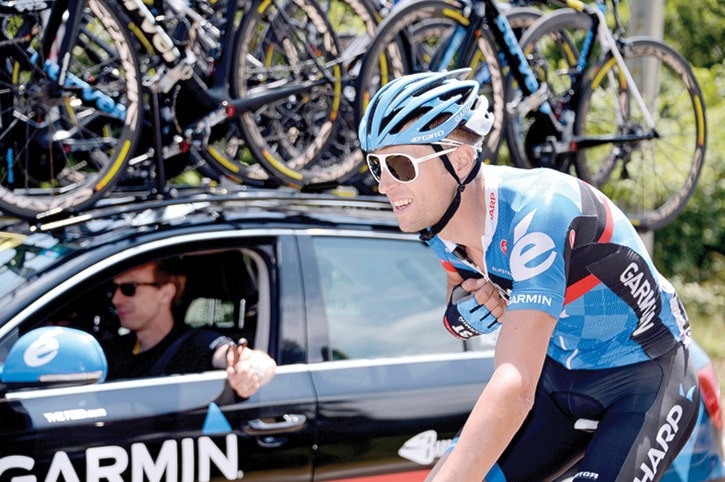Not sure if Canadians wanted a history lesson on doping in cycling this week, but they sure got one.
Speculation that Victoria cyclist Ryder Hesjedal doped in 2003 became truth after he was forced to admit it on Wednesday.
Danish cyclist Michael Rasmussen’s new book Yellow Fever is the latest tell-all of a career enhanced by doping, in his case from 1998 to 2010. In it, he tells of introducing synthetic erythropoietin (EPO), which boosts the red-blood cell count, to Hesjedal and Seamus McGrath during their world series mountain biking season in 2003. He goes on to suggest it helped them qualify for the 2004 Olympics.
Hesjedal released a statement on Wednesday through Slipstream Sports, the parent company of his Garmin-Sharp cycling team, admitting to the matter:
“… even though those mistakes happened more than 10 years ago, and they were short-lived, it does not change the fact that I made them and I have lived with that and been sorry for it ever since. To everyone in my life, inside and outside the sport – to those that have supported me and my dreams – including my friends, my family, the media, fans, my peers, sponsors – to riders who didn’t make the same choices as me all those years ago, I sincerely apologize for my part in the dark past of the sport. I will always be sorry.”
Unfortunately, this shouldn’t have come as a shocker.
Hesjedal and McGrath should be absolved, for the most part, for any sins from those days. They competed in a different time, an asterisk-era for the sport of cycling. Many of Hesjedal’s teammates on Garmin have already been implicated, suspended and banned for sins pre-Garmin, including core members of the team David Zabriskie and Christian Vande Velde, who were part of the U.S. Postal Service team with Lance Armstong. Vande Velde recently served a six-month ban ending in March 2013 for blood doping with the U.S. Postal Service team from 2004-06.
Hesjedal’s crime is petty in comparison. It’s possible he wouldn’t be the Hesjedal we know today if he hadn’t taken the risk that he did to stay in cycling’s elite circles back then.
“I believe that being truthful will help the sport continue to move forward, and over a year ago when I was contacted by anti-doping authorities, I was open and honest about my past,” Hesjedal said. “I have seen the best and the worst of the sport and I believe that it is now in the best place it’s ever been.”
Tyler Hamilton said in his 2012 book The Secret Race, if you didn’t dope, you wouldn’t be competing in the world’s best races. It was Hamilton who finally brought down Lance Armstrong. Hamilton, a former U.S. Postal Service teammate of Armstrong’s, said the cyclists even had a name for those who raced without performance enhancing drugs (PEDs): paniagua (from the Spanish phrase for bread and water), during the seven-straight years that Armstrong won Tour de France championships from 1999 to 2005.
Hamilton goes out of his way to point out that Jonathan Vaughters, another former teammate of Armstrong’s, didn’t like doping and Armstong pushed Vaughters off the team.
Vaughters is the director of Garmin-Sharp, Hesjedal’s team, which was built on a mantra of clean racing. The team is so transparent, not only is it squeaky clean in terms of PED test results, but it makes a policy of releasing its cyclists’ data after race stages. (The data shows the daily wattage output by the cyclist and it’s not rocket science that a wattage reading is one of the easiest measures for PED usage. What’s more is Garmin, a GPS company, makes the power meters to sell to everyday cyclists. It’s quite genius, really.)
It’s not to say cycling isn’t healing from a dark time. It is. But Hesjedal’s 2012 Giro D’Italia win still stands as a great achievement.
And personally, after evading the topic for five years, I’m relieved.
I, like most Canadian media, had completely ignored the topic of Hesjedal’s history and PEDs. I guess I figured he wore a blindfold and ear plugs before and druing his time on Lance Armstong’s U.S. Postal Service team in 2004-05, when it ran “the most sophisticated, professionalized and successful doping program the sport has ever seen,” said the U.S. Anti-Doping Administration. Granted, Hesjedal wasn’t on the Tour de France yet, but he was among cycling’s elite at a time when EPO was the drug of choice.
Which is why books like Rasmussen’s and Hamilton’s are great for the sport. The books may anger a few cyclists but overall they help the sport heal and move forward, which Garmin-Sharp has been a leader in doing since 2007. Cycling is healing itself, and cyclists calling each other out is part of the process. The real scandal is if a positive test result comes from a Garmin-Sharp cyclist in 2014. Now, that would be news.
sports@vicnews.com
